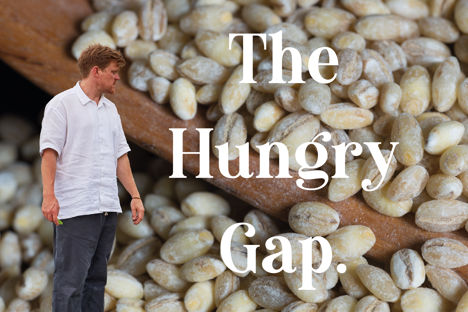
Sam Buckley: on the 'Hungry Gap'
Sam Buckley, founder of Where The Light Gets In, talks us through how he navigates designing the restaurant's menu during the hungry gap, and making the most of Britain's winter veg.
View more from this series:
Sam Buckley on...As the temperature drops and the first frost sets in, at Where The Light Gets In we are busy preparing for the time of year known traditionally as the ‘Hungry Gap’.
Before the advent of growing with artificial energy in polytunnels and flying produce in from overseas, the Hungry Gap referred to a time of year when fresh food grown by traditional methods starts to slow down. It is a time when the English kitchen garden dies back, leaving only a handful of brassica and roots. As we don’t use produce grown abroad or out of season ingredients, we enjoy this time immensely as it tests our creativity and resources to come up with a delicious and inventive menu for our guests.
The Hungry Gap lasts from December right up until the end of April, which is when the first broad beans are picked from their pods. It means we are left to rely on roots such as celeriac, parsnips and potatoes, along with the likes of cured squash, grains and pulses, shellfish and the plethora of preserves that we have prepared in advance.
We begin to use the smoker and add more fats to our dishes in order to get a depth and richness that will combat the chill. We serve a broth to the beginning of the menu to welcome our guests in from the cold. We add richness to dishes using cheese. There are still some things that can be sourced from the wild, too. We take the last of the rosehips, haws, three-cornered leek, chestnuts and roots from dandelion and burdock.
We favour the use of game at this time of year, either in the form of venison fresh form the cull or wild mallards that are shot in order to protect the seeds now sown for the spring harvest. We also take farmed Pekin duck from small-scale farmers. These we age for up to two weeks and smoke them before finishing them on the barbecue. Even though the barbecue is associated with the summer I think it has a fitting place in the darker months, as the flavours of charcoal and smoke bringing a sense of warmth and comfort.
Pickles at this time of year bring a spark and energy to the palate in replacement of fresh herbs. If summer is abundant in the variety of produce available then the winter matches that with the diversity of ideas and techniques that we draw out of a less-varied selection of ingredients.
One such dish that always remains through these months is a porridge. Enabling the diner to hug a deep, warm bowl, to be comforted by this very motion of eating with a spoon, holding the bowl close to their chest – it gives a true vision of winter comfort.
We use a variety of grains for our porridges such as wheat, barley, rye, spelt and millet. After a night soaking where they ferment and break down just a little we will cook them gently in a stock made of mushrooms or chicken wings. We add whey to lighten the whole thing then add the grains one by one to a master pot. The porridge will be finished with some mushrooms fried lightly in butter, chicken livers to the same effect or scoops of roasted squash. A salty cheese sauce made by emulsifying melted cheese with water adds richness.
Though a dish such as this doesn’t seem fitting for a fancy dining menu it tells such a lovely story of the humble offerings of this time of year and the generosity one can find through scooping into a warm bowl of gently cooked grains. A hearty, comforting and honest representation of the food available in this particular corner of the world at this particular time of the year.


